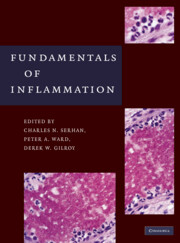Book contents
- Frontmatter
- Contents
- Contributors
- Preface
- PART I THE INFLAMMATORY RESPONSE – AN OVERVIEW
- 1 Acute and Chronic Inflammation
- 2 Resolution of Acute Inflammation and Wound Healing
- 3 Links between Innate and Adaptive Immunity
- PART II INDIVIDUAL CELL TYPES
- PART III CHEMICAL MEDIATORS
- PART IV IMMUNOPHARMACOLOGY
- PART V INFLAMMATORY DISEASES/HISTOLOGY
- PART VI ANIMAL MODELS OF INFLAMMATION
- Index
- References
1 - Acute and Chronic Inflammation
from PART I - THE INFLAMMATORY RESPONSE – AN OVERVIEW
Published online by Cambridge University Press: 05 April 2014
- Frontmatter
- Contents
- Contributors
- Preface
- PART I THE INFLAMMATORY RESPONSE – AN OVERVIEW
- 1 Acute and Chronic Inflammation
- 2 Resolution of Acute Inflammation and Wound Healing
- 3 Links between Innate and Adaptive Immunity
- PART II INDIVIDUAL CELL TYPES
- PART III CHEMICAL MEDIATORS
- PART IV IMMUNOPHARMACOLOGY
- PART V INFLAMMATORY DISEASES/HISTOLOGY
- PART VI ANIMAL MODELS OF INFLAMMATION
- Index
- References
Summary
INTRODUCTION
The inflammatory response consists of an innate system of cellular and humoral responses following injury (such as after heat or cold exposure, ischemia/reperfusion, blunt trauma, etc.), in which the body attempts to restore the tissue to its preinjury state. In the acute inflammatory response, there is a complex orchestration of events involving leakage of water, salt, and proteins from the vascular compartment; activation of endothelial cells; adhesive interactions between leukocytes and the vascular endothelium; recruitment of leukocytes; activation of tissue macrophages; activation of platelets and their aggregation; activation of the complement; clotting and fibrinolytic systems; and release of proteases and oxidants from phagocytic cells, all of which may assist in coping with the state of injury. Whether due to physical or chemical causes, infectious organisms, or any number of other reasons that damage tissues, the earliest in vivo hallmark of the acute inflammatory response is the adhesion of neutrophils (polymorphonuclear leukocytes, PMNs) to the vascular endothelium (“margination”) (Figure 1.1). The chronic inflammatory response is defined according to the nature of the inflammatory cells appearing in tissues. The definition of chronic inflammation is not related to the duration of the inflammatory response. Reversal or resolution of the inflammatory response implies that leukocytes will be removed either via lymphatics or by apoptosis (programmed cell suicide) and that the ongoing acute inflammatory response is terminated.
- Type
- Chapter
- Information
- Fundamentals of Inflammation , pp. 1 - 16Publisher: Cambridge University PressPrint publication year: 2010
References
- 9
- Cited by



